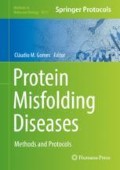Abstract
Pharmacological chaperones are small molecular weight molecules that bind specifically to protein targets and stabilize unstable and misfolded conformations. In particular, there is an increasing interest in the application of this type of compounds for the correction of genetic conformational disorders, which are caused by mutations leading to protein instability. The discovery of compounds with pharmacological chaperone ability is customarily initiated by a high-throughput screening of chemical libraries searching for stabilizing binders. However, there is no established consensus for the subsequent steps. Therefore, here, we introduce an example of a successful protocol directed to the discovery of pharmacological chaperones with potential for the therapeutic correction of phenylketonuria, a defect caused by mutations in the enzyme phenylalanine hydroxylase.
Access this chapter
Tax calculation will be finalised at checkout
Purchases are for personal use only
References
Chen B, Retzlaff M, Roos T, Frydman J (2011) Cellular strategies of protein quality control. Cold Spring Harb Perspect Biol 3(8):a004374
Sontag EM, Samant RS, Frydman J (2017) Mechanisms and functions of spatial protein quality control. Annu Rev Biochem 86:97–122
Kevei E, Pokrzywa W, Hoppe T (2017) Repair or destruction-an intimate liaison between ubiquitin ligases and molecular chaperones in proteostasis. FEBS Lett 591(17):2616–2635
Muntau AC, Leandro J, Staudigl M, Mayer F, Gersting SW (2014) Innovative strategies to treat protein misfolding in inborn errors of metabolism: pharmacological chaperones and proteostasis regulators. J Inherit Metab Dis 37(4):505–523
Labbadia J, Morimoto RI (2015) The biology of proteostasis in aging and disease. Annu Rev Biochem 84:435–464
Hartl FU (2017) Protein misfolding diseases. Annu Rev Biochem 86:21–26
Blau N, van Spronsen FJ, Levy HL (2010) Phenylketonuria. Lancet 376(9750):1417–1427
Flydal MI, Martinez A (2013) Phenylalanine hydroxylase: function, structure, and regulation. IUBMB Life 65(4):341–349
Wettstein S, Underhaug J, Perez B, Marsden BD, Yue WW, Martinez A, Blau N (2015) Linking genotypes database with locus-specific database and genotype-phenotype correlation in phenylketonuria. Eur J Hum Genet 23(3):302–309
Underhaug J, Aubi O, Martinez A (2012) Phenylalanine hydroxylase misfolding and pharmacological chaperones. Curr Top Med Chem 12(22):2534–2545
Convertino M, Das J, Dokholyan NV (2016) Pharmacological chaperones: design and development of new therapeutic strategies for the treatment of conformational diseases. ACS Chem Biol 11(6):1471–1489
Pey AL, Ying M, Cremades N, Velazquez-Campoy A, Scherer T, Thony B, Sancho J, Martinez A (2008) Identification of pharmacological chaperones as potential therapeutic agents to treat phenylketonuria. J Clin Invest 118(8):2858–2867
Hole M, Jorge-Finnigan A, Underhaug J, Teigen K, Martinez A (2016) Pharmacological chaperones that protect Tetrahydrobiopterin dependent aromatic amino acid hydroxylases through different mechanisms. Curr Drug Targets 17(13):1515–1526
Lee JA, Carragher NO, Berg EL (2017) Empirical drug discovery: a view from the proteome. Drug Discov Today Technol 23:1–5
Wang J, Zhang X, Fang Y, Liang X (2016) Label-free cell phenotypic assays for assessing drug polypharmacology. Curr Pharm Des 22(21):3190–3200
Schenone M, Dancik V, Wagner BK, Clemons PA (2013) Target identification and mechanism of action in chemical biology and drug discovery. Nat Chem Biol 9(4):232–240
Flatmark T, Stokka AJ, Berge SV (2001) Use of surface plasmon resonance for real-time measurements of the global conformational transition in human phenylalanine hydroxylase in response to substrate binding and catalytic activation. Anal Biochem 294(2):95–101
Martínez A, Knappskog PM, Olafsdottir S, Døskeland AP, Eiken HG, Svebak RM, Bozzini M, Apold J, Flatmark T (1995) Expression of recombinant human phenylalanine hydroxylase as fusion protein in Escherichia coli circumvents proteolytic degradation by host cell proteases. Isolation and characterization of the wild-type enzyme. Biochem J 306:589–597
Acknowledgments
This work was supported by The Research Council of Norway (RCN; Program Forny2020 248889/O30 and FRIMEDBIO 214012), the infrastructure project Nor-Openscreen (RCN), and The K.G. Jebsen Foundation. We thank Guri E. Matre and Ming Ying for expert technical assistance.
Author information
Authors and Affiliations
Corresponding author
Editor information
Editors and Affiliations
Rights and permissions
Copyright information
© 2019 Springer Science+Business Media, LLC, part of Springer Nature
About this protocol
Cite this protocol
Aubi, O., Knappskog, P.M., Martinez, A. (2019). Early Stage Discovery and Validation of Pharmacological Chaperones for the Correction of Protein Misfolding Diseases. In: Gomes, C. (eds) Protein Misfolding Diseases. Methods in Molecular Biology, vol 1873. Humana Press, New York, NY. https://doi.org/10.1007/978-1-4939-8820-4_18
Download citation
DOI: https://doi.org/10.1007/978-1-4939-8820-4_18
Published:
Publisher Name: Humana Press, New York, NY
Print ISBN: 978-1-4939-8819-8
Online ISBN: 978-1-4939-8820-4
eBook Packages: Springer Protocols

